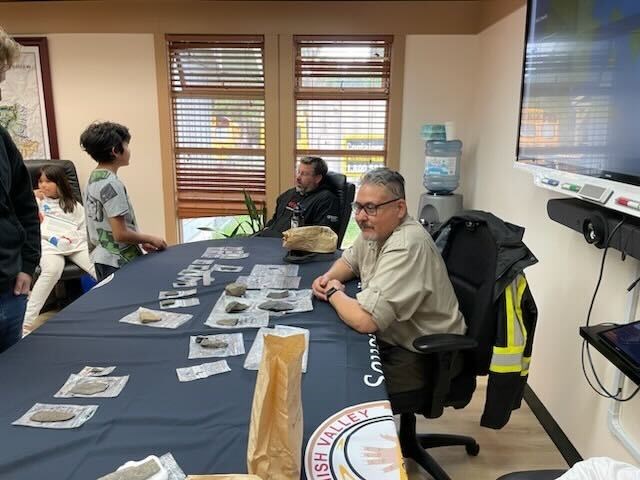There’s an ongoing archaeological project on the Sta’7mes (Stawamus ) reserve in Squamish that is part of a broader movement to decolonize archeology, according to Rudy Reimer, an associate professor of archeology and First Nations studies at Simon Fraser University (SFU), and a member of the Sk╠▒wx╠▒wu╠ü7mesh U╠üxwumixw (Squamish Nation).
SFU archeology students and the Nation are working together to protect the Sta’7mes site, which holds deep cultural significance.
The ongoing archaeological work at the Sta’7mes site involves excavating to uncover and preserve artifacts and cultural deposits that hold significant historical and cultural value for the Nation.
According to the press release from SFU, students and researchers are specifically focused on identifying the types of artifacts present, the condition of these deposits (whether they are intact or disturbed), and understanding the broader historical context of the site.
Evan Mugford, a recent SFU archeology graduate student looks back at a complex stone and on the field.
“What stood out to me most is the extremely dense and rich amount and diversity of ancestral belongings we recovered during our work,” Mugford said.
"It was humbling holding something that you know hasn't seen the light of day since someone stood there and created it hundreds or thousands of years ago.”
“Definitely,” Reimer said when asked if the project aligns with the larger decolonization effort.
“Archeology on a reserve is unique, but we also aim to extend this practice off-reserve, addressing misconceptions people living off-reserve may hold.”
“There’s often a fear among landowners that if there’s an archaeological site on their land, it could lead to a land claim or loss of property. However, as Indigenous communities, we’ve never said that. We just want to ensure that any archaeological deposits are managed responsibly.”
The ' toolkit highlights the growing threats to First Nations heritage and stresses the need for stronger protections, of ones like this one in Squamish.
Spiritual Significance
The approach to archeology at Sta’7mes is influenced by the site’s spiritual connection to the Nation, guiding both the excavation efforts and the overall methodology, Reimer said.
“In my research and teaching at SFU Archeology, I focus on braiding or weaving together different kinds of knowledge, particularly through a cultural lens. This cultural knowledge, including place names and oral histories, is passed down orally and deeply informs how we approach archeology.”
Specific rituals and protocols are integral to the excavation process, ensuring respect for the cultural heritage being uncovered, according to Reimer.
“A crucial part of our field school is the day we bring in cultural and spiritual leaders to discuss protocols. We go over how to take care of themselves, how to look after each other, and how to be aware of culturally sensitive matters,” Reimer said.
“We also emphasize that it’s OK to ask questions if they’re unsure about something culturally.”
Integrating Indigenous and western knowledge
For Reimer, this openness to questioning and learning is key to the work at Sta’7mes, where blending Indigenous knowledge with Western scientific methods is a careful process. The project seeks to blend these two perspectives.
“The older school of archeology focused on artifact styles and how they change over time. These are very useful, but the time periods were often arbitrarily named by older scholars. We have terms like the Locarno Beach phase, Marpole phase, or Charles culture, which have little meaning to Indigenous communities.”
Reimer emphasized the importance of aligning archaeological practices with the Nation's understanding of time, which is based on cultural knowledge.
“An Elder who was interviewed by an anthropologist in the late 1800s described the history of the Squamish people using a stick with four notches, each representing a different time period. This process took days to explain,” Reimer said.
Educating the next generation
The Sta’7mes project is also focused on educating future archaeologists. “The way we structure our field school is that students start on campus, where they learn the basics of mapping and other techniques,” Reimer said.
“But more importantly, we involve cultural and spiritual leaders to ensure students are fully engaged with the cultural significance of Sta’7mes, beyond just the technical aspects.”
Community involvement has been essential to the project’s success. Reimer recalled a moment of engagement with the Squamish community:
“At the request of the community, particularly the Elders and youth, people visited while we were digging. To engage them, I prepared a teaching kit from previous excavations. They were fascinated to learn that the artifacts came from their grandma's yard.”
Looking to the future
Looking ahead, Reimer envisions Sta’7mes as a site of ongoing preservation and education. “There are parts of the site I’d love to dig more, but any future impacts will guide our work. It’s a big, complex site, so whatever we do, whether for research or heritage management, will be of interest,” he said.
Reimer sees the Sta’7mes project as part of a larger movement toward decolonizing archeology, aimed at preserving the past while ensuring future generations can learn from and honour the cultural heritage that sites like Sta’7mes represent.
“This project and others can show that archeology, when done respectfully, is not a bad thing. It’s about much more than just digging up the past—it’s an opportunity to preserve and learn from cultural heritage in a way that honours the community.”
Bhagyashree Chatterjee is The ąĪ└Č╩ėŲĄ’s Indigenous and civic affairs reporter. This reporting beat is made possible by the

.png;w=120;h=114;mode=crop)


